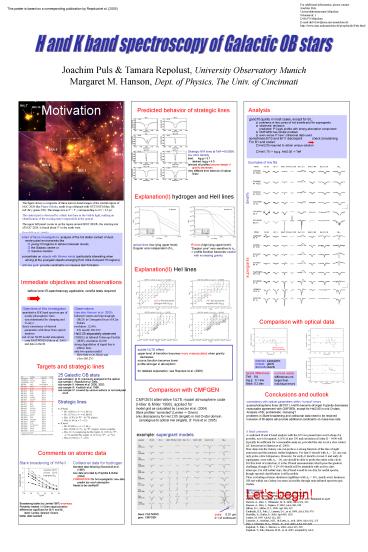poster template - PowerPoint PPT Presentation
1 / 1
Title:
poster template
Description:
problems in Stark-broadening and collisional data need to be ... Infrared Camera and Spectrograph (IRCS) at Cassegrain focus of 8.2m Subaru. resolution: 12,000, ... – PowerPoint PPT presentation
Number of Views:27
Avg rating:3.0/5.0
Title: poster template
1
For additional information, please
contact Joachim Puls, Universitätssternwarte
München Scheinerstr. 1 D-81679 München E-mail
uh101aw_at_usm.uni-muenchen.de http//www.usm.unimuen
chen.de/people/puls/Puls.html
This poster is based on a corresponding
publication by Repolust et al. (2005)
- H and K band spectroscopy of Galactic OB stars
Joachim Puls Tamara Repolust, University
Observatory Munich Margaret M. Hanson, Dept. of
Physics, The Univ. of Cincinnati
Examples of line fits
dwarfs
supergiants
Immediate objectives and observations
before lone IR-spectroscopy applicable, careful
tests required
- Objectives of this investigation
- quantitative H/K band spectroscopy of mostly
photospheric lines (uncontaminated by clumping
and X-rays) - check consistency of derived parameters with
those from optical analyses - test of our NLTE model atmosphere code FASTWIND
(Puls et al. 2005) and data in the IR
- Observations
- (see also Hanson et al. 2005)
- Infrared Camera and Spectrograph (IRCS) at
Cassegrain focus of 8.2m Subaru - resolution 12,000, S/N mostly 200-300
- HeI2.05 separately observed
- CSHELL at Infrared Telescope Facility (IRTF),
resolution 24,000 - strong degradation of signal due to telluric
lines - only two spectra useful HD190864 (O6.5III(f) and
t Sco (B0.2V)
Conclusions and outlook
- consistency with optical parameters within
normal errors - quasi-photospheric lines (Br10/11, HeI/II) become
stronger if gravity decreases - reasonable agreement with CMFGEN, except for
HeI2.05 in mid O-stars - Analysis of Br? problematic clumping?
- problems in Stark-broadening and collisional data
need to be resolved - inclusion of Br-alpha will provide additional
constraints on mass-loss rate
A final comment A combined H and K band analysis
with the S/N we present here won't always be
possible, nor is it required. A S/N of just 150
and resolution of order R 5000 will typically
be sufficient for a reasonable analysis, provided
the star is not a slow rotator (cf. discussion in
Hanson et al. 2005). How deep into the Galaxy
one can probe is a strong function of the line of
sight extinction and the intrinsic stellar
brightness. For late-O dwarfs with AV 20, one
can only probe a few kiloparsecs. However, for
early-O dwarfs or most O and early-B supergiants,
even with AV 20, one should be able to probe
the entire solar circle. For this level of
extinction, it is the H band measurements which
pose the greatest challenge, though S/N 120-150
should still be attainable with an 8-m class
telescope. For still redder stars, the H band
would be too dim for useful spectra, though
spectral classification is still possible. Thus,
excluding extreme situations (sightlines with AV
gt 30) , nearly every luminous OB star within our
Galaxy becomes accessible through near-infrared
spectroscopic studies. Lets begin!
example supergiant models
squares Br11circles Br10 trianglesBr?
References
Bik, A., Lenorzer, A., Kaper, L., et al. 2003,
AA 404, 249Giovanardi, C., Natta, A., Palla, F.
1987, AAS, 70, 269Hanson, M.M., Kudritzki,
R.P., Kenworthy, M.A., et al. 2005, submitted to
ApJSHerrero, A., Puls, J., Villamariz, M. R.
2000, AA 354, 193Herrero, A., Puls, J.,
Najarro, F. 2002, AA 396, 949Hillier, D.J.,
Miller, D.L. 1998, ApJ 496, 407Kudritzki, R.P.,
Puls, J., Lennon, D.J., et al. 1999, AA 350,
970Przybilla, N., Butler, K. 2004, ApJ 609,
1181Lemke, M. 1997 AAS 122, 285Lenorzer, A.,
Mokiem, M.R., de Koter, A., et al. 2004, AA 422,
275Puls, J. Urbaneja, M.A., Venero., R., et al.
2005, AA 435, 669 Repolust, T., Puls, J.,
Herrero, A. 2004, AA 415, 349Repolust, T.,
Puls, Hanson, M.M., et. al. 2005, accepted by AA
scale 0.01 µm0.1 of continuum
black FASTWIND grey CMFGEN































